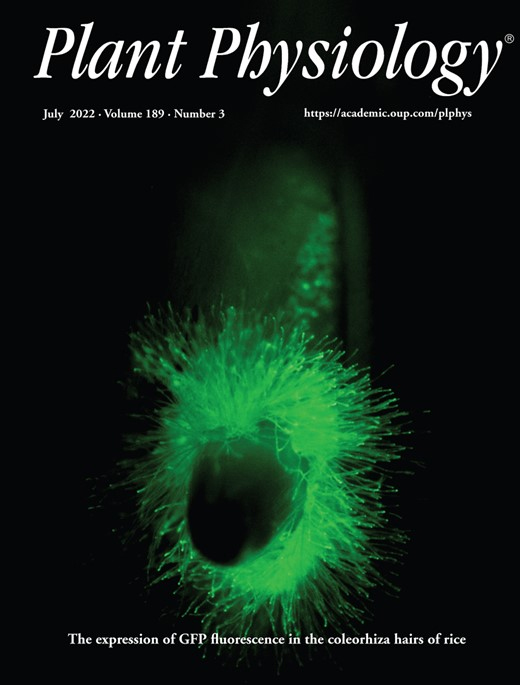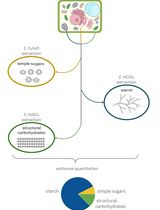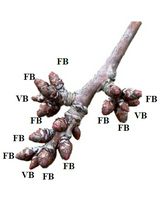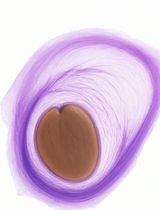- EN - English
- CN - 中文
Analysis of Pectin-derived Monosaccharides from Arabidopsis Using GC–MS
拟南芥果胶单糖的GC–MS分析
发布: 2023年08月20日第13卷第16期 DOI: 10.21769/BioProtoc.4746 浏览次数: 1896
评审: Samik BhattacharyaCătălin VoiniciucKumiko Okazaki
Abstract
Pectin is a complex polysaccharide present in the plant cell wall, whose composition is constantly remodelled to adapt to environmental or developmental changes. Mutants with altered pectin composition have been reported to exhibit altered stress or pathogen resistance. Understanding the link between mutant phenotypes and their pectin composition requires robust analytical methods to detect changes in the relative monosaccharide composition. Here, we describe a quick and efficient gas chromatography–mass spectrometry (GC–MS)-based method that allows the differential analysis of pectin monosaccharide composition in plants under different conditions or between mutant plants and their respective wild types. Pectin is extracted from seed mucilage or from the alcohol-insoluble residue prepared from leaves or other organs and is subsequently hydrolysed with trifluoracetic acid. The resulting acidic and neutral monosaccharides are then derivatised and measured simultaneously by GC–MS.
Key features
• Comparative analysis of monosaccharide content in Arabidopsis-derived pectin between different genotypes or different treatments.
• Procedures for two sources of pectin are shown: seed coat mucilage and alcohol-insoluble residue.
• Allows quick analyses of neutral and acidic monosaccharides simultaneously.
Graphical overview

Background
Primary cell walls consist of up to 90% polysaccharides including cellulose, hemicelluloses, and pectin (Pettolino et al., 2012; Höfte and Voxeur, 2017). Of those, pectin is characterised by high amounts of D-galacturonic acid, which forms the backbone in the pectic polysaccharides homogalacturonan and rhamnogalacturonan II. In a third pectic polysaccharide, rhamnogalacturonan I, the backbone consists of disaccharide units of D-galacturonic acid linked to L-rhamnose (Atmodjo et al., 2013). Further mono- or oligosaccharide side chains are linked to the backbone, resulting in a chemically complex structure (Harholt et al., 2010; Atmodjo et al., 2013).
Pectin is the most abundant component of primary cell walls of many plant species and performs diverse functional roles, including the response to infection by various pathogens (Shin et al., 2021). In this context, it was reported that an Arabidopsis double mutant line, disrupted in the two galacturonic acid–producing enzymes GLUCURONATE 4-EPIMERASE 1 and 6, contained less homogalacturonan and concomitantly showed higher susceptibility towards infection with the pathogens Pseudomonas syringae pv maculicola ES4326 and Botrytis cinerea isolates (Bethke et al., 2016). Also, modifications of the pectin backbone have been connected to plant–pathogen interactions. In Arabidopsis, POWDERY MILDEW RESISTANT5 (PMR5) is responsible for the acetylation of galacturonic acid, and the pmr5 mutant has been shown to possess enhanced resistance to powdery mildew (Vogel et al., 2004). Furthermore, the bxl4 Arabidopsis mutant that lost enzyme activity of BETA-XYLOSIDOSE4 (BXL4) exhibited increased susceptibility to the fungal pathogen B. cinerea. BXL4 has been shown to possess activities on cell wall–derived arabinans and xyloses (Guzha et al., 2022).
Given the reported effects of changes in pectin abundance and composition, fast and straightforward methods to compare the relative composition of pectin in plants under different conditions or of different genotypes are essential. Different methods for compositional analysis have been described so far, including colorimetric assays, gas chromatography–mass spectrometry (GC–MS), and high-pressure liquid chromatography-based approaches (Pettolino et al., 2012; Biswal et al., 2017; Bethke and Glazebrook, 2019; Dean et al., 2019). Among those, GC–MS-based methods require analytes volatile enough for GC separation. Two main methods to obtain volatile analytes are described in the literature: reduction and acetylation to alditol acetates or acidic methanolysis of the sample followed by trimethylsilylation. The latter procedure offers the advantage of analysing neutral and acidic monosaccharides simultaneously; however, methanolysis is a time-consuming process with incubation times of 18 h (Biswal et al., 2017). We therefore intended to combine shorter sample processing times with the simultaneous study of neutral and acidic monosaccharides.
We describe a GC–MS-based analysis of cell wall pectin extracted from cell wall samples as alcohol-insoluble residue (AIR) or seed coat mucilage by water extraction. Subsequently, extracted pectin is hydrolysed with trifluoracetic acid (TFA) that can be evaporated to leave the monosaccharide monomers. These are then derivatised with O-methylhydroxylamine hydrochloride (MOX) and N-methyl-N-(trimethylsilyl)trifluoroacetamide (MSTFA) to yield volatile analytes to be analysed by GC–MS.
Materials and reagents
Reagents
Ultrapure water (prepared, for example, with a water purification system)
Liquid nitrogen
Nitrogen (N2) gas
Acetone (Carl Roth, catalog number: 9372.5)
Chloroform (Carl Roth, catalog number: 7331.1)
Undenatured ethanol
Methanol (Fisher Scientific, catalog number: 10124490)
Pyridine anhydrous (Sigma-Aldrich, catalog number: 270970)
Trifluoroacetic acid (TFA) (Sigma-Aldrich, catalog number: 302031)
O-Methylhydroxylamine hydrochloride (MOX) (Sigma-Aldrich, catalog number: 226904)
N-Methyl-N-trimethylsilyltrifluoroacetamide (MSTFA) (Sigma-Aldrich, catalog number: 69479)
allo-Inositol (Sigma-Aldrich, catalog number: 468088)
L-Arabinose (Sigma-Aldrich, catalog number: A91906)
L-Fucose (Sigma-Aldrich, catalog number: F2252)
D-Galactose (Carl Roth, catalog number: 4987.2)
D-Galacturonic acid monohydrate (Sigma-Aldrich, catalog number: 48280)
D-Glucose (Carl Roth, catalog number: 6780.2)
D-Glucuronic acid sodium salt monohydrate (Sigma-Aldrich, catalog number: G8645)
D-Mannose (Sigma-Aldrich, catalog number: M8574)
L-Rhamnose monohydrate (Carl Roth, catalog number: 4655.2)
D-Xylose (Sigma-Aldrich, catalog number: X3877)
Solutions
70% ethanol (see Recipes)
2 M trifluoroacetic acid (TFA) (see Recipes)
allo-Inositol (see Recipes)
Monosaccharide standards (see Recipes)
O-Methylhydroxylamine hydrochloride (MOX) derivatisation solution (see Recipes)
Recipes
70% ethanol
Reagent Final concentration Quantity Ethanol (absolute) 70% 70 mL H2O n/a 30 mL Total n/a 100 mL 2 M trifluoracetic acid (TFA)
Reagent Final concentration Quantity TFA (13 M) 2 M 1.54 mL H2O n/a 8.46 mL Total n/a 10 mL Add the acid slowly to ultrapure water. 10 mL of 2 M TFA solution is enough for the hydrolysis of 30 samples. Caution: TFA is corrosive and attacks skin, eyes, and mucous membranes. Wear chemical-resistant gloves and safety goggles and work with TFA only under a fume hood.
allo-Inositol
Reagent Final concentration Quantity allo-Inositol 50 μg/mL 5 mg H2O n/a 100 mL Total n/a 100 mL Monosaccharide standards
Reagent Final concentration Quantity L-Arabinose 250 mM 37.53 mg in 1 mL of water D-Xylose 250 mM 37.53 mg in 1 mL of water L-Fucose 250 mM 41.04 mg in 1 mL of water L-Rhamnose 250 mM 45.54 mg in 1 mL of water D-Galactose 250 mM 45.04 mg in 1 mL of water D-Glucose 250 mM 45.04 mg in 1 mL of water D-Mannose 250 mM 45.04 mg in 1 mL of water D-Galacturonic acid 250 mM 53.04 mg in 1 mL of water D-Glucuronic acid 250 mM 58.54 mg in 1 mL of water Note down the actual mass that you weighed in and adjust the volume using the following formula:

O-Methylhydroxylamine hydrochloride (MOX) derivatisation solution (see General note 3)
Reagent Final concentration Quantity MOX 30 mg/mL 15 mg Pyridine anhydrous n/a 0.5 mL Total n/a 0.5 mL Caution: Pyridine is harmful if swallowed, in contact with skin, or if inhaled. Wear chemical-resistant gloves and work with pyridine and MOX solutions only under a fume hood. Use solvent-resistant tips for pipetting.
Laboratory supplies
10 cm plant pots
Soil: Einheitserde SPECIAL Vermehrung, Patzer Erden, Sinntal-Altengronau, Germany; medium clay content, contains peat, perlite, 1% nutrient salts, trace elements and iron, pH 5.8
Chemical-resistant gloves
Safety goggles
Solvent-resistant pipette tips [Biozym, catalog numbers: 693010 (10 μL), 692069 (200 μL), 692078 (1,000 μL)]
Vials, inserts, and lids for GC–MS [Macherey-Nagel, catalog numbers: 702282 (vials), 702716 (inserts), 702287.1 (lids)]
Glass beads, 5 mm diameter (Carl Roth, catalog number: HH56.1)
2 mL microcentrifuge tube (Sarstedt, catalog number: 72.695.500)
1.5 mL microcentrifuge tube (Sarstedt, catalog number: 72.690.001)
DURAN® culture tubes with screw cap (VWR, catalog number: 391-4022)
Equipment
Growth chamber with light and temperature controls
Oven for sterilization of soil at 80 °C
Fume hood
Gas chromatography–mass spectrometry (GC–MS) system:
Agilent Technologies 7890B GC-System coupled to 5977B MSD quadrupole
PAL3 Auto sampler system with Robotic Tool Change (RTC)
HP-5ms Ultra Inert column (Agilent, catalog number: 19091S-433UI)
Nitrogen evaporator/sample concentrator
Analytical balance (Kern, model: 770-15)
Rotary shaker
Microcentrifuge
Heating block with shaker for 2 mL microcentrifuge tubes (HLC HTM 130, Haep Labor Consult)
Heating block for DURAN glass tubes (LiebischTM Monoblock)
Ball mill (Retsch MM400)
Optional: Mortar and pestle
Vortex mixer (Vortex-Genie 2)
Micropipettes
Acid resistant micropipette
Laboratory spatulas
Software
GC/MSD MassHunter with MSD ChemStation Data Analysis (G1701FA F.01.03.2357; Agilent Technologies)
Microsoft Excel 2019 (Microsoft)
Procedure
文章信息
版权信息
© 2023 The Author(s); This is an open access article under the CC BY license (https://creativecommons.org/licenses/by/4.0/).
如何引用
Scholz, P., Chapman, K. D., Ischebeck, T. and Guzha, A. (2023). Analysis of Pectin-derived Monosaccharides from Arabidopsis Using GC–MS. Bio-protocol 13(16): e4746. DOI: 10.21769/BioProtoc.4746.
分类
植物科学 > 植物生物化学 > 糖类
生物化学 > 糖类 > 多糖
您对这篇实验方法有问题吗?
在此处发布您的问题,我们将邀请本文作者来回答。同时,我们会将您的问题发布到Bio-protocol Exchange,以便寻求社区成员的帮助。
提问指南
+ 问题描述
写下详细的问题描述,包括所有有助于他人回答您问题的信息(例如实验过程、条件和相关图像等)。
Share
Bluesky
X
Copy link












